There is much more to the Milliken Bugatti Type 35A than just an incident at Watkins Glen.
By Pete Vack
According to Bill Milliken, the acquisition of his first sports car was simply elementary. While visiting New York City in 1946, he happened upon a shiny black MGTB, asked the owner if he’d like to sell, wired home for the $1500 necessary to title it in his name and drove it up to Albany.
At a time when the average price of a new American car was about $1200, the TB was a bit pricey, being a 1940 model and right hand drive. It was very similar to the later TC, with the same snazzy wire wheels, upright chromed radiator grille, and the same 54 hp engine, but only 379 TBs were made before the War stopped production at Abingdon.
Milliken was in seventh heaven; his previous transportation was a secondhand Chevy that was “…little more exciting than a grocery cart.” His thoughts of the early Duesenbergs and Millers of his boyhood returned to him and he found himself in a “machine that turned on all my senses and made driving a delightful experience….my childhood euphoria of driving had returned, and I was to never lose it.”
In Albany, Milliken’s cousin and mentor Ed Waterhouse suggested Bill join the new national sportscar club that had its base in Hartford Connecticut. Milliken joined the SCCA and was soon a guest in the home of Russ Sceli, a local foreign car dealer and enthusiast. Sceli would become the second president of the SCCA, and was known for a fine collection of cars including Bugattis. He had just finished the restoration of a Bugatti Type 35A, chassis 4906. Milliken was “bowled over” by the Bugatti, even though he’d only owned the MG for a month or two, Sceli told him he’d take the MG TB and $2000 for the T35A. A done deal. (Read review “Equations of Motion”)

Dick Wharton poses with the Type 35A on the track at Alexandria Bay, New York, August 7th 1937. Alexandria Bay was a 'round the houses' race held in a small town on an island on the St. Lawrence River. Wharton would place 7th in the event. Photo courtesy of Sandy Leith.
A historic Bugatti
Although not very important at the time, this particular T35A had a great history. American Bugatti Club Registrar Sandy Leith called it “quite possibly the most significant GP Bugatti in U.S. amateur racing history.” Its U.S. history began with George C. Rand, a gentleman driver and an early Automobile Racing Club of America (ARCA) member who established an official Bugatti Agency in New York in the mid 1930s. Rand had fallen in love with Bugattis when longtime friend Hunt Bancroft Smith brought a Type 35A over from London in 1932. Smith had bought the Bugatti from the Malcolm Cambell Agency while on his honeymoon, but his wife hated it and threatened divorce if he didn’t get rid of it immediately. Beauty is in the eye of the beholder and Rand was standing in line for the Bugatti and was soon in possession of chassis 4906, which was later photographed next to his Gee Bee racing airplane. Like Milliken, Rand loved airplanes and spent a good deal of time at the Curtis-Wright Flying School in Garden City, New Jersey. He attended Harvard and took some classes at MIT. Later in life, Rand became involved with the Owl’s Head Transportation Museum in Owl’s Head, Maine, where Milliken’s homebuilt plane is still on display.
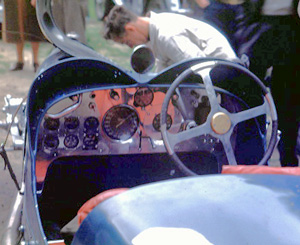
A photo by Harold Lance of the Milliken Bugatti cockpit at the Glen in 1948. The small group of instruments installed by Halley can be seen at the left. This image is part of the many color images now available on a DVD.
The fickle Halley sold the T35A in 1935 to Dick Wharton, another good looking preppy and friend of Rand’s. When not on the floor of the stock exchange, Wharton was developing his skills as a race driver and the T35A was perfect for the task. But it also served two other drivers, Bob Fuller and Paul Wilson for the next five years in a variety of ARCA events.
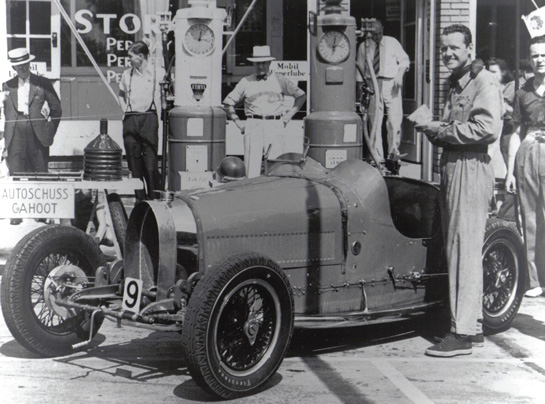
Bob Fuller stands next to the Type 35A after purchasing the car from Dick Wharton. The event is Alexandria Bay, on August 12th 1939. Note the extra cowl on the radiator, an attempt to cool the Bug in the August temperatures. Fuller would co drive the car with George Rand and garner a fourth overall. Photo courtesy of Sandy Leith.
ARCA Record for Bugatti T35A, chassis 4906
1935 May 19th, Sleepy Hollow Ring, NY, 3rd, Dick Wharton
1935 June 23rd Briarcliff Manor, NY, 3rd Dick Wharton
1937, August 7th, Alexandria Bay, NY, 7th, Dick Wharton
Sold to Bob Fuller for $1000 in 1938
1938 August 6th, Alexandria Bay, NY, 5th, Bob Fuller
1939 August 12th, Alexandria Bay, NY, 4th, Bob Fuller
Sold to Paul Wilson in 1940
1940 July 6th, Montauk, NY, 7th Paul Wilson
1940, August 10th, Alexandria Bay, NY, 4th, Paul Wilson
1940, October 6th, NY World’s Fair, 10th, Paul Wilson
Sold to Russ Sceli, 1946, restored, and sold to William Milliken
Milliken was not able to pick up his Bugatti until late October 1946, and while he got the MG TB to Connecticut in fair weather, driving back with the definitely open Bugatti met with snow showers and below zero weather. He stuffed newspapers in his jacket and made it back to Buffalo, where the car began its preparations to conquer the 1947 edition of Pikes Peak.

A true engineer, the first thing Milliken did with the Type 35A was to tear it down. He added five inches to the wheelbase and modified the steering. The Bugatti created ‘great interest and curiosity among our engineering staff and mechanics, ‘ wrote Milliken of his workers at CAL. Reprinted with permission from Equations of Motion, Copyright Bentley Publishing, all rights reserved, www.Bentleypublishers.com
Modifications to 4906
With the enthusiastic help of the (off-hours) team at Cornell Aeronautical Laboratory (CAL) in Buffalo, the Bugatti was lengthened by almost five inches to 98 ¾ inches to meet event wheelbase regulations by using extension blocks of 4130 heat treated steel bolted inside the chassis rails; the front shocks were moved further out, new unit rim and spider steering wheel, steering post and drag links were constructed. A new, heavy duty and much thicker radiator replaced the original and due to that, a new front cowl was created to cover the larger radiator.
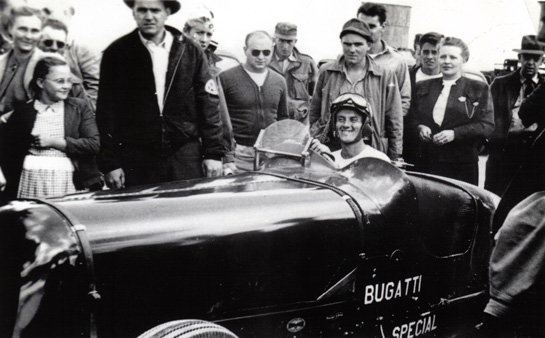
The modifications to the Bugatti were successful…note the revised radiator. Milliken got his first taste of competition, and success as the car placed 6th overall at Pikes Peak in 1947, seen here at the start. Milliken decided that the only way to beat the opposition was to use four wheel drive. Photo courtesy of Sandy Leith.
Their efforts were well rewarded with a sixth overall…first time racing, the first time at the 100 corner 12 mile course up Pikes Peak, with a car that was now 15 years old. The Type 35A wouldn’t return to the Peak but Milliken would.
Milliken wouldn’t let the Bugatti rest, insisting upon driving the 300 miles from Buffalo to Albany in the winter again, this time with chains and cold weather gear. He made it after a series of breakdowns and mishaps, he finally accomplished the mission, driven largely on the old stagecoach routes.
At the Glen
Becoming a very active member of the new SCCA, Milliken helped lay the groundwork for the round the houses event at Watkins Glen with his new friend Cameron Argetsinger. Milliken drove from Buffalo with the Bugatti (it was, after all, his daily transportation) and qualified for the first Watkins Glen Junior Grand Prix held on October 2nd 1948. The Bugatti radiator and horseshoe grille was replaced and the car looked splendid.
Despite lack of racing experience, Milliken had moved up to fourth after four laps and then passed Haig Ksayian in a supercharged MGTC. Coming down into Thrill Corner the rear end broke away, the car spun, hit the haybales, and rolled over. Milliken was wearing a safety belt and a helmet…rare in those days..so got out from under the car with nothing but a scratched elbow. But as he extracted himself from the Bugatti, Ksayian nearly ran him over. He missed, and the corner became known throughout the world as Milliken’s Corner. Ironically, one minor accident overshadowed the most impressive race record of 4906, in the hands of Milliken and the previous owners.
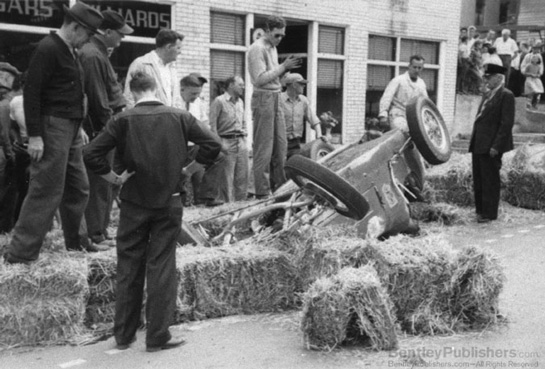
The Type 35A after the rollover at Watkins Glen. Milliken was unhurt as he was wearing a safety belt and helmet. But as he emerged from the car, he was almost hit by MG driver Haig Ksayian. The Bugatti was tough, hardly damaged in the incident. Reprinted with permission from Equations of Motion, Copyright Bentley Publishing, all rights reserved, www.Bentleypublishers.com.
Milliken’s last race with 4906 took place at Bridgehampton on June 11th 1949. While fenderless cars…aka Grand Prix cars…were allowed at the Glen, the organizers at the Bridge wanted fenders, so a set were fabricated at CAL. At first attached to the backing plates, the fender supports soon fractured enroute to the event, and attached to the frame before the race. It was fun but unsuccessful. “I thoroughly enjoyed the race until I lost it at Clubhouse Corner and bent a steering rod.
Doctor Sam Scher, a New York plastic surgeon, owned several bigger Bugattis and soon Milliken was driving a T51 followed by the ex-Varzi Type 54, a huge, fast, and difficult Bugatti. Again, Milliken and the crew from CAL took the T54 on, and after the original transmission developed an incurable crack, the team adopted a Buick Dynaflow Torque Converter to replace the broken Bugatti manual transmission. Heresy, said some, but the team really had no choice. Besides, the conversion worked fine, but Milliken rolled the T54 at the Glen in 1950, no doubt the only person to have rolled two Bugattis at the same venue.
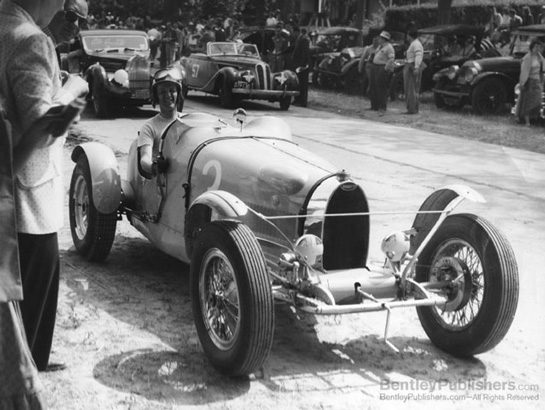
Milliken took the Type 35A to Bridgehampton in 1949. The fenders were required for the event. As usual, Milliken drove the Bugatti to the event. He retired after smiting a haybale hard enough to bend the steering rod. Milliken would sell it in 1950. Reprinted with permission from Equations of Motion, Copyright Bentley Publishing, all rights reserved, www.Bentleypublishers.com.
Millken sold the Type 35A in 1950 to on Ervin Fuller, who reportedly owned it for the next twenty years. From then on the history is hazy, going through Kirk F. White and raced in France for several years. It reportedly re appeared at Retro in 2009 and is now in the hands of European collector Heinz Bachmann, who is returning it to the Mac Halley-Zumbach configuration with extra gauges and other details.
The lead photo was taken by the Editor of a mural in downtown Watkins Glen on Franklin Street. The art is by Bob Gillespie, depicting “Milliken’s Corner.”
Our thanks to Janet Barnes at Bentley Publishing, Douglas and Bill Milliken, and a special thanks to ABC Registrar Sandy Leith for the use of photos from his collection.
Sources
“George Rand, Gentleman Driver”, Al Bochroch, Automobile Quarterly, V17-1
Automobile Racing Club of America, Joel Finn, Garnet Hill Publishing, 1995
Equations of Motion, William Milliken, Bentley Publishing 2008
“Mister Supernatural”, Karl Ludvigsen, Automobile Quarterly, V44-1
www.bugattibuilder.com, thread on 4906, February 16 2009 author unknown
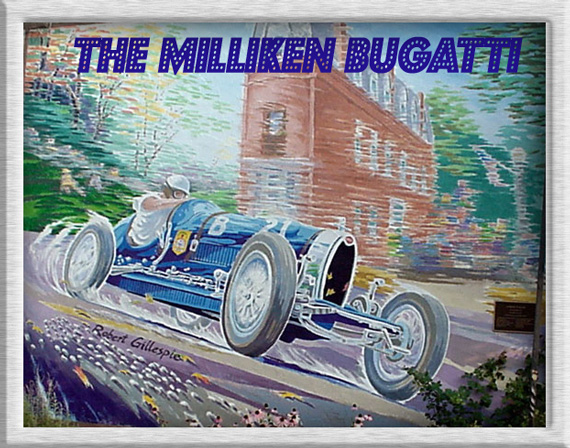
Poor car, after all these modifications there was not much Bugatti left, would be nice to convert it back to its original condition.
Vive la marque!
Au contraire my friend. It would be a disaster it were returned to the initial configuration from Molsheim. Do remember that this is a historic car not for what it was, but for what it became in the hands of the enthusiast engineer Milliken.
There are many, many “original” Bugs out there. But then, to the wise observer a car or any other object can only be original once.
What a Guy ! .
Met Bill at Goodwood F.O.S, in 2009 ? , He was 97 Then , and Drove the Hill 6 Times in 3 Days !! .
The Sunday it was Raining Very Hard , But Bill would Go .
I Convinced the Chef at the Goodwwod Hotel , that he didn’t want Bill’s Demise on his Watch ? , and we , ” Gained ” , a Great Roll of Towel , to Bail Out the Car ! .
Fantastic Memories , Great Man , Great Family .
Happy 101 , William MillikenJr. !!! ………………..
Poor car indeed! According to an article in Pur Sang 4906’s line of ownership was interrupted by theft, while according to Bugantics (Conway Sr) 4906’s identity was in doubt.
What a gentleman Bill Milliken is. What an ingenious engineer he is. His addition of the Buick automatic transmission predates Jim Hall’s in the Chaparrals by 16 years or so. Bill told me that when one of the Colliers saw the conversion he said:”That’s the future of racing.” How right he was, but it took Jim Hall to complete the circle Bill started in his Bugatti.
Cheers,
John R. Wright